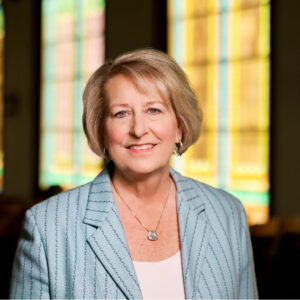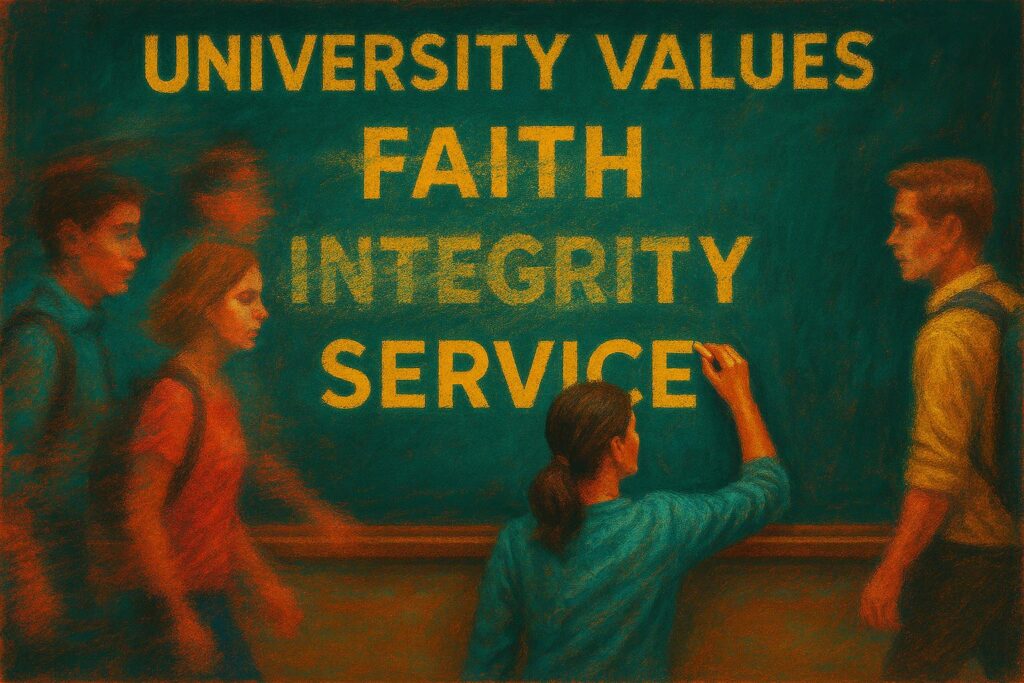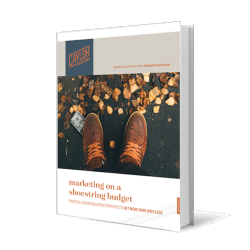How to Create a Generative AI Playbook for Small College Marketing Teams
Build smarter campaigns with this generative AI playbook for small college marketing—tools, workflows, and staff training that actually work.
Branding
It’s no secret that many private universities are navigating turbulent waters, making the need for a higher ed turnaround strategy more relevant than ever.
Declining enrollment, mission drift, and increasing pressure to “do more with less” have left many faith-based institutions at a crossroads.
But what does it look like when a university not only survives—but begins to thrive—without sacrificing its core values?
 In this episode of The Higher Ed Marketer podcast, Dr. Amy Bragg Carey, president of Friends University, shares a compelling story of institutional transformation.
In this episode of The Higher Ed Marketer podcast, Dr. Amy Bragg Carey, president of Friends University, shares a compelling story of institutional transformation.
She takes us behind the scenes of a decade-long journey that blended faith, data, AI, and relentless mission focus to fuel an authentic comeback.
As a president brought in to solve financial challenges and reclaim a lost identity, Dr. Carey offers wisdom not only for fellow presidents but also for marketing teams, advancement leaders, and anyone involved in shaping a university’s brand and future.
When Dr. Carey stepped into leadership at Friends University, she inherited more than a budget deficit, she inherited a crisis of identity.
We’d been losing money in our operating budget for many years and really didn’t have much in cash reserves. But also, we had an identity issue. Who are we as a Christian university?
These two issues—financial instability and mission drift—often go hand-in-hand in higher education.
When financial resources are strained, it’s easy for colleges to compromise on their core values in the name of short-term survival.
In the confusion, they begin cutting essential programs, softening their messaging, or shifting focus away from mission-driven initiatives.
Over time, these small compromises compound, weakening both brand identity and internal morale.
For Friends University, reclaiming its faith-based identity wasn’t a cosmetic change.
It was central to its long-term survival.
Dr. Carey took a transparent, trust-building approach from day one.
I don’t know exactly how we got here, but we’re here. And we have to make these changes to move forward as a university, to thrive as a university. That is my goal, and I hope you’ll follow me in this process.
It’s a leadership posture that prioritized consistency, clarity, and mission fit over quick fixes.
A: Universities rebuild trust by communicating transparently, aligning decisions with their mission, and engaging stakeholders consistently over time. In higher ed turnaround strategies, trust-building is essential for unifying teams and reassuring prospective students and donors.
Friends University is rooted in the Quaker tradition, a heritage that values inclusion, service, and seeing every person as made in the image of God.
But over time, these distinctives had faded.
When I first came to Friends, we didn’t even have chapel. Chapel had been discontinued.
In response, she led efforts to restore a vibrant spiritual culture on campus without alienating students or faculty from diverse backgrounds.
It’s our vision to be the preferred Christian university in the region. You can come and live out your faith here but you’re also going to bump up against people with different views, different perspectives. That creates a real-world experience.
The “middle lane” of Christian higher education—too Christian for some, not Christian enough for others—may be narrow, but Dr. Carey sees it as a strength.
And it’s a lane more students are seeking: faith that engages, not isolates.
The result?
Record enrollments and a renewed sense of purpose across campus.
Friends University partnered with Caylor Solutions to dive deep into understanding its key audiences.
One of the most transformative tools?
We’ve reviewed and rewritten emails to align with these personas. It’s helping us reshape messaging and personalize communications with different audience groups.
Personas helped the enrollment and marketing teams move beyond transactional appeals, like scholarships, and into the realm of motivations and student identity.

“It’s not all about the money,” Dr. Carey reflected. “It’s about motivations, interests, and what would be captivating to them.”
But Friends didn’t stop at building personas.
They brought them to life.
One of the most innovative parts of the university’s higher ed turnaround strategy was using AI to deepen audience understanding.
Caylor Solutions helped train ChatGPT on the school’s unique student personas—creating custom “agents” that marketing staff could interact with to refine messaging.
Dr. Carey admitted she’s still learning the technology, but she’s excited by its potential.
It’s pretty cool and kind of beyond me. But it’s fascinating to our team. Our younger staff in enrollment and marketing have engaged with those AI personas and had conversations. We’re just at the tip of it.
It’s sharpened language, clarified motivation, and increased emotional resonance in communications.
The use of AI here isn’t just a gimmick.
It’s a practical outgrowth of Friends University’s broader shift toward intentional, strategic communication that aligns with both audience and mission.
A: AI tools in higher education marketing are used to analyze behavior, personalize communications, automate workflows, and simulate interactions through persona-driven agents. These innovations support enrollment growth and are increasingly part of modern higher ed turnaround strategies.
When asked how Friends achieved record enrollment and the second-highest numbers in their school history, Dr. Carey was honest.
People ask, ‘How did you do that?’ And I think it’s 10 years of lots of strategies. If anybody’s looking for a silver bullet—we all know in higher ed, it’s just not there.
She’s also quick to credit moments of divine provision like seven-figure gifts from donors who aligned with the renewed mission.
That mix of stewardship and opportunity is what allowed the institution to go from financial crisis to flourishing.
One of the most practical insights in the episode came when Dr. Carey outlined what mission drift looks like.
It’s not usually a dramatic departure.
It’s death by a thousand paper cuts.
It’s slow. It’s little slips here and there. Chapel moved off campus. Bible courses got downplayed. Words started to get fuzzy.
This emphasizes just how much leadership sets the tone for the rest of the university.

Dr. Carey encouraged boards and campus leaders to be vigilant.
You maybe have to do more and be a little more proactive to keep the mission front and center.
At Friends, that included reestablishing chapel, highlighting student-led Bible studies, and telling stories of faith in action, not just in campus ministry, but in classrooms, athletics, and student life.
A: Mission drift occurs when a college gradually shifts away from its founding values, often due to financial pressure, leadership changes, or unclear brand messaging. Over time, this can erode trust, weaken student fit, and damage long-term institutional success.
Dr. Carey also acknowledged a challenge many faith-based institutions face: translating mission into language that resonates with students and parents who are also looking for tangible outcomes.
Her solution?
Go beyond taglines and tell better stories.
We try to highlight things like Bible studies in the residence halls, or Sunday nights at nine. That’s all student-led.
It’s not just what administration is programming—it’s what’s organically happening.
She also challenged other Christian universities to be more descriptive.
Can we go deeper than just saying we build servant leaders? What does that look like? How do we do that?
In other words, impact stories are the bridge between mission and marketing—and they matter now more than ever.
At the end of the conversation, Dr. Carey left us with one line that perfectly sums up her approach: “The mission always wins.”
That clarity has kept Friends University on track even as it adapted, innovated, and used tools like AI to stay relevant.
Dr. Carey’s journey proves that a higher ed turnaround strategy doesn’t have to come at the cost of core values.
In fact, the most sustainable transformations are built on faithfulness, not flashiness.
If your institution is facing similar headwinds, her story offers hope and a very practical roadmap.
🎧 For even more insights from Dr. Amy Bragg Carey, listen to the full episode on The Higher Ed Marketer podcast.
Want to Build a Comeback Strategy of Your Own?
Just like Friends University discovered, true transformation begins when you’re willing to take an honest look at what’s working—and what’s not.
If your institution is navigating declining enrollment, unclear messaging, or mission drift, it may be time for a comprehensive Enrollment Assessment.
At Caylor Solutions, we specialize in uncovering the roadblocks hiding inside your admissions workflows, communication strategies, and student engagement tactics.
We’ll deliver a detailed, actionable report that includes:
✅ Streamlined admissions workflow recommendations
✅ Communication tactics optimized for mission-fit students
✅ Persona-driven engagement strategies
✅ Retention insights that reduce melt and boost satisfaction
Whether you’re experiencing enrollment decline or just want a clearer path forward, this is the strategic reset your institution needs.
Because, as Dr. Amy Bragg Carey reminded us, “The mission always wins”—but only if your strategy supports it.
Let’s align your enrollment strategy with your values and turn things around for good.
Schedule your Enrollment Assessment today.
Set yourself free from your shrinking marketing budget with my popular ebook Marketing on a Shoestring Budget! This ebook is jammed with practical ways to produce high-quality marketing on the cheap.
Inside, I’ll show you proven marketing tactics like…
No hype. No pie in the sky. Just real solutions for getting the job done with the budget you’ve got.
Featured image via friends.edu
Subscribe to The Higher Ed Marketer podcast today!